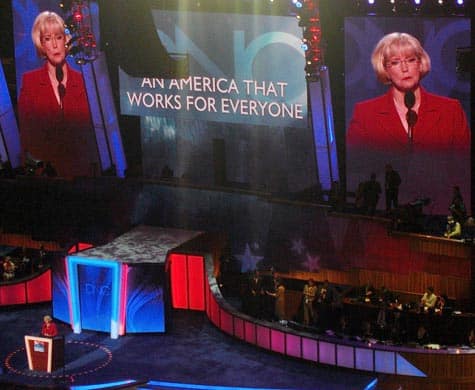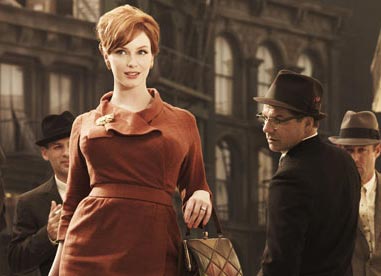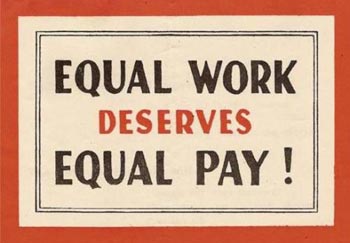by Beverly Cooper Neufeld
A small cadre of women rallied on the steps of New York’s City Hall on April 28th, 2007, the day known as a Equal Pay Day. This day marks the time when a working woman catches up to what a white male earned in the previous year – she puts in 16 months of work to make what he earned in 12 months pay. It is a calendar translation of the often-recited statistic that a woman earns 77 cents to one dollar earned by a man.

Sponsored by the New York Women’s Agenda, this was the first ever recognition of Equal Pay Day in New York City. Those of us on the steps wore red because when it comes to pay, women are in the red. We were also seeing red, but turned that energy into the formation of a new coalition of 41 diverse organizations that is attempting to transform our town into the best city in the nation for working women. Called the Equal Pay Coalition NYC (EPCNYC), we are leading the way for New York City to take the lead in addressing the persistent pay gap.
Talk about Equal Pay is all the rage today. The Wall Street Journal blogged about Equal Pay Day. Lilly Ledbetter became a news fixture after she helped get a law passed to extend the time limitations for cases of secret pay discrimination — she had been denied compensation on those grounds for years of underpayment. A long-running lawsuit against Wal-Mart for paying less to women has been given the go-ahead in court, and in May, a jury awarded women at Novartis Pharmaceuticals substantial sums in back pay and punitive damages after finding of sex discrimination in the compensation.
There is a growing recognition, nationally and globally, that women’s economic security and well-being is a vital issue of our day, closely linked to the nation’s security, financial recovery and future health. But, there is little forward movement to create the needed change.
Overcoming the “Mad Men” Mentality
On the federal front, our Equal Pay laws, passed in the early 1960s when the world of “Mad Men” was not fiction, are weak. A partial fix, legislation known as the Paycheck Fairness Act is closer to passage this year because of the united effort of major women’s groups organized by the American Association of University Women (AAUW). It has a tough Senate fight ahead, and that’s before the midterm elections. The Paycheck Fairness Act would strengthen current “equal pay for equal work laws” and protect workers from retaliation for sharing salary information. It has a chance, unlike the languishing Fair Pay Act, which would tackle “equal pay for work of equivalent value,” a critical reform but more difficult to explain and institute, making it harder to rally support.
| Sexism and stereotyping influence the pay a woman takes home. |
A few states have initiated stronger regulations than federal law provides, most notably Minnesota, which instituted public sector pay equity in 1982 and continues to monitor salaries. Last year, New Mexico took the lead by conducting pay equity analysis of its state workers and by requiring contractors with the state to provide pay equity reports. This may prove to be a successful way to make private sector companies examine – and realign – their pay practices. When vendors protest, “Do we have to?” Martha Burk, the feminist magician behind the scenes, simply replies, “No you don’t….unless you want a government contract.”
Public opinion is increasingly in favor of change. Both the 2009 Shriver Report and June 2010 Pew Research Center’s Global Attitudes Project confirm that Americans know women are underpaid and their opportunities for employment are limited. President Obama, summed it up in May on the 47th anniversary of the Equal Pay Act: “Women now make up nearly half of the nation’s workforce, most homes have two working parents, and 60 percent of all women work full-time. As we emerge from one of the worst recessions in American history, when families are struggling to pay their bills and save for the future, pay inequity only deepens that struggle and hampers our economy’s ability to fully recover.”

This administration priority was spotlighted in July when Obama’s new National Equal Pay Enforcement Task Force called for passage of the Paycheck Fairness Act, improved data collection, public education and enforcement. The Department of Labor also rolled out a series of initiatives, including an Equal Pay Checklist, a revamped Equal Pay Employer Self-Audit tool, and an Equal Pay Research Summit, in addition to the White House’s Work-Flex program. All positive progress.
With two-thirds of families with children dependent on a mom’s salary, many as primary breadwinners, fair pay can’t come soon enough. This great recession is increasing the urgency because so many men are losing jobs, making women’s paychecks the basis of financial stability. These “New Breadwinners,” as Heather Boushey describes them, smash the ’60s stereotype of women working for “pin money.” They are working for survival. Almost 30 percent of families with a female head-of-household are poor, and 15 percent are living in deep poverty. So, good jobs and fair pay are profoundly important to them and millions of other women working to make ends meet.
So far, education is not the antidote for inequity we imagined. No matter one’s educational level, from day one, the disparity is present. A woman will earn more with a college-degree, but still earn less than her male counterpart. This loss of income over time — the “career gap” — for a high school grad can be as much as $700,000, and for women with college and advanced degrees, $1.2 to 2 million dollars! Women do not just lose wages, but pension savings, Social Security and years of investments. (This leaves older women particularly vulnerable and explains their high poverty rates.) Evelyn Murphy, author of “Women Are Getting Even” (WAGE), advises women to make this personal and gets her audiences to shout out, “I want my million dollars!” Now that’s inspiring!
So, there is this reality for women in the U.S.: Poverty is up and wages are down. Our equal pay laws are outdated and our concept of equal pay is limited. Sexism and stereotyping continue to shape a woman’s experience in the workforce and the check she takes home at the end of the week. This affects women, their families and our nation. But, knowing and doing something about it are two different things.
Why the U.S. remains in this 1960s reality is important to understand as many longtime advocates plot a 21st century campaign for Pay Equity.
At its heart is the continuing and deeply rooted sexism within our society, our decision makers and ourselves which results in undervaluing, underpaying and under-appreciating the work of women. Or, as pay equity author and activist Ellen Bravo says, “That’s why those who care for our young children earn less than those who care for our cars, our pets, our lawns.” The necessary “see” change may happen over time, but workers and their families need remedies – stronger protections – now.
Five Key Proposals to Quicken the Pace
How to affect this change has been the focus of advocates for decades. In New York, the struggle for equal pay for work of equivalent value goes back 30 years to the Long Island based Women on the Job Task Force, which brought a complaint to the NY State Division of Human Rights. After a 10- year investigative and judicial process, the task force was informed that the clerical employees in the Sachem School District could not get fair pay because there was no law against unequal pay for different job titles even though they require equal levels of skills and responsibilities.

Their advocacy led to a one-time pay equity adjustment for NYS workers, but there was strong resistance to institutionalizing this concept into law. A disappointing outcome for advocates, but their fire did not burn out. More recently, the state coalition NYSPEC has been working for a comprehensive pay equity and worker protection package, which has been passed annually since 2002 by only one house. It is edging closer in the state Senate, but remains unpassed.
The Equal Pay Coalition NYC had an additional idea. We began to look at city-based laws – after all, this is the nation’s largest city and has a population bigger than many states, as well as headquarters for innumerable companies.
In 2008, the New York City Council showed that it was favorably disposed by unanimously passing two resolutions calling for the passage of the NYS Pay Equity bills and the federal Paycheck Fairness Act. We reasoned that we might garner wider support and more immediate results from New York City that could ultimately influence outcomes on the state and federal stages.
At a recent hearing of the Women’s Issues Committee, Equal Pay Coalition NYC’s Agenda for Change presented New York City officials with five key proposals, as described in our Pay Equity Guide.
1. Equal Pay for Work of Equivalent Value: We recommended that New York City amend its Human Rights law to cover work of equivalent value. Protections for equal pay for work of equivalent value more effectively strike at the wage disparity that affects female workers, particularly women of color. Research also reveals this approach is an effective anti-poverty tool.
2. Equal Pay for Equal Work: We recommended that New York City amend its Human Rights law to protect workers against retaliation when they share salary information that promotes fair pay practices. While progress is being pursued on the federal and state level, New York City has a unique opportunity to protect its workers and create a model for the country.
3. Access to Better Jobs: Being paid equitably for a low wage job would certainly boost the earnings of large numbers of women, but garnering better paying jobs which a family can live on is essential to breaking the cycle of poverty for New York City women. We recommended that New York City institute a strong commitment to “non-traditional” jobs that offer women a living wage.
4. Access to Capital for Minority and Women Business Enterprises: A lack of funds continues to hinder the success of women and minority businesses, which, in turn, slows the “economic engine” of the city and nation. We recommended that New York City adopt measures to improve the success of minority and women-owned business enterprises in city contracting by setting higher goals, mandating their use and monitoring the contracts. (Good news: New York State passed a strong Minority and Women Business Enterprise law this session.)
5. Task Force on Pay Equity: Achieving parity and opportunity for women is a complex, long-term undertaking. The Equal Pay Coalition NYC called for the creation of an officially sanctioned entity to study policy issues and to recommend enforceable procedures that promote fiscal parity and equal opportunity for New York City women. For example, the task force could oversee pay equity audits of city agencies and develop pay equity standards for private contractors doing business with the city. A task force could also educate and engage the business community as a partner in making ours the “Best City for Working Women.”
We aim to manifest a fairer, more robust economic environment for women, families and our community. It is our patch of what could be a grassroots wave — a national web of collaboration — to push for, insist on, demand, and, ultimately, secure reforms that protect, promote and nourish women’s economic health. We hope that others will jumpstart this effort in their communities. Our checkbooks depend on it.
Beverly Cooper Neufeld is a consultant to non-profits, VP of the New York Women’s Agenda and Director of the Equal Pay Coalition NYC, and formerly Executive Director of The White House Project. She can be reached at [email protected].
Also see Featured Video: “Women Under The Hood” by Ann Farmer in this edition of On The Issues Magazine.
See “How to Think Like A Feminist Economist” by Susan Feiner in the Spring 2010 edition of On The Issues Magazine.
Visit The Café of On The Issues Magazine for new stories and updates.
